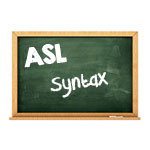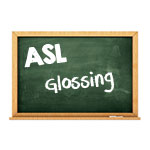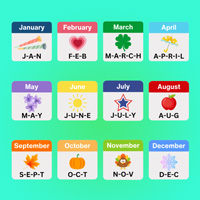Learning Tips Articles
ASL Syntax
In addition to having its own vocabulary, American Sign Language also has its own grammar and syntax that differs from English.
ASL glossing and conventions
Since ASL is a visual-gestural language, not a spoken consecutive language, it can only truly be recorded in video and not captured in writing. Many writing systems have been developed for ASL, but none of them have reached a critical mass, probably because it is difficult to capture handshape, location, palm orientation, movement and non-manual signals in a written word. For that reason, when scribing ASL, many people rely on the linguistic convention called "glossing," which means writing a word in your native language for each sign that appears. This is not a perfect system, but it can be useful when discussing the syntax of other languages, signed or spoken.
Signing Thank You
We have had many people ask about signing THANK YOU to family and friends, and also giving thanks to God during this holiday season. In the case of THANK YOU to family and friends (or kind strangers!), you will want to sign the normal thank you gesture by moving your open flat hand out and down from your face, but do so in the direction of the person you are thanking. You can remember the sign for thank you because it ...
Holiday Sign Extravaganza
Tis the season to be jolly! Below are several holiday-oriented signs and word lists to help celebrate (or at least communicate about) the holidays in sign.
Holiday Signs
We WISH you many BLESSINGS this HOLIDAY SEASON, including HEALTH, HAPPINESS, time spent with FAMILY and FRIENDS, and PEACE, LOVE, and JOY.
View our Holiday Word List
Santa Claus Signs
Have you been NAUGHTY or NICE this year? Make sure to hang your STOCKINGS and put out MILK and COOKIES for SANTA CLAUS.
View our Santa Claus Word ...
10 signs to know for Thanksgiving
From THANK YOU to NATIVE AMERICAN to TURKEY, here is a fun, themed list of 10 signs to know for Thanksgiving.
Say Thank You and Use Polite Words
As you are giving thanks this Thanksgiving, remember to show your love and appreciation for the special people in your life and be kind and polite to all. Learn about using polite words in this WonderGrove Kids animation featuring sign language from Signing Savvy.
Developed by Educators, the Use Polite Words animation has accompanying lesson plans and extension lessons that align to the Common Core Standards for Pre-K through Second Grade.
Plus, there are over 100 more animations at WonderGrove Kids. The ...
The Importance of Coupling Writing with Signing
I know, you never thought you would hear me ("The Man in the Blue Shirt") say that deaf children are signing too much, right? Well I say it only in perspective of comparing their signing skills to their writing skills.
I think there are often times in the field of Deaf Education that the parents, teachers and interpreters that are working with the deaf and hard of hearing population are just so excited that the children are beginning to express themselves ...
The many facets of sign language
Sign language is not a universal language.
Unfortunately sign language is NOT universal throughout the world. There is American Sign Language, British Sign Language, Spanish Sign Language, Japanese Sign Language, Ausian (Australian Sign Language) and many more. In fact, there are even multiple sign languages used in the United States (American Sign Language, Signed Exact English, regional dialects, etc.). Although one universal sign language would probably make things easier, just like with spoken language, the world would have a very difficult ...
Happy Valentine's Day!
We hope you have a great Valentine's Day! This is a reposting of our blog post from last Valentine's day. It does a great job of covering all the different ways to show LOVE... in sign language that is!
Many people know and use the sign for I LOVE YOU. This sign is used universal throughout the country and the world. We see it all over television, at sporting events and during "shout outs" to our mothers. The sign is actually ...
Thinking BROAD as you learn sign
Recently I visited with a group of parents of young deaf children who were sharing their frustrations and struggles with learning sign. They were asking for tips to improve their skills as their families learn the language of their young deaf children. Their question is one that I hear often, and I know I have addressed it in previous blogs, but because I hear it so much, I thought it might be good to discuss it again. I will also ...
ADVERTISEMENTS













